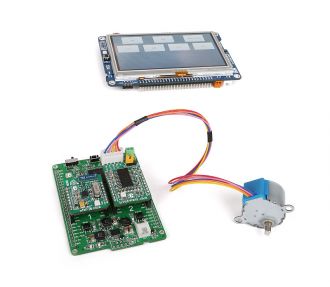
We strongly encourage users to use Package manager for sharing their code on Libstock website, because it boosts your efficiency and leaves the end user with no room for error. [more info]

Rating:
Author: MIKROE
Last Updated: 2016-02-19
Package Version: 1.0.0.0
Example: 1.0.0.0
Category: Motor Control
Downloaded: 1365 times
Followed by: 3 users
License: MIT license
This is a simple demonstration of using nRF and Stepper click boards for wirelessly controlling the stepper motor. Master module sends command to the slave (ON, OFF, DIRECTION, 1 step, 1/2 step, 1/4 step and 1/8 step). Upon reception, slave processes this command and drives stepper motor.
Do you want to subscribe in order to receive notifications regarding "Wireless Stepper Motor Control" changes.
Do you want to unsubscribe in order to stop receiving notifications regarding "Wireless Stepper Motor Control" changes.
Do you want to report abuse regarding "Wireless Stepper Motor Control".
| DOWNLOAD LINK | RELATED COMPILER | CONTAINS |
|---|---|---|
| 1414595458_wireless_stepper_mikroc_arm.rar [204.10KB] | mikroC PRO for ARM |
|

Features mikromedia Plus for STM32, clicker 2 For STM32, nRF C click and Stepper click board.
View full imageThis is a simple demonstration of using nRF and Stepper click boards for wirelessly controlling the stepper motor. The master nRF24LO1P is on the mikromedia+ for STM32. The touch-screen interface on the board allows you to choose to drive the motor clockwise or counter-clockwise, in full-, half-, quarter- and eighth-step modes. The commands are received by the slave module on nRF C click that drives the motor via stepper click.
This fine and demanding project was developed by Ivan Palijan, one of our interns.
